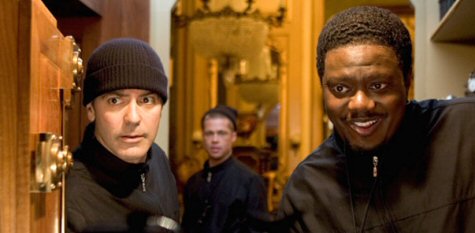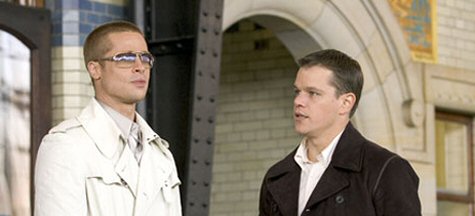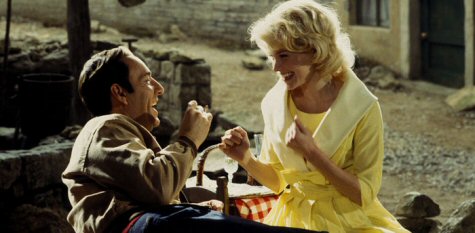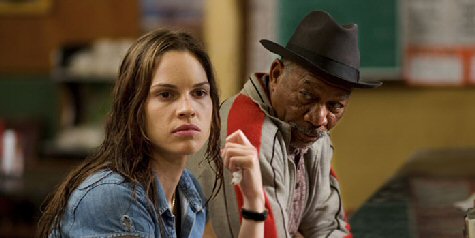Empty Jape
Ocean’s Twelve (Warner Bros., playing everywhere) isn’t quite abominable. You could be a hard-ass and call it that, but then you wouldn’t be cool.
It’s expensive and smart-assed and scenic as hell, and not in the least bit stupid. It’s a very hip enterprise. There’s just nothing there. Some goofy guy humor but no major laughs, no thrilling set pieces, no especially tasty performances, no suspense…just a bunch of kool kats (George Clooney, Brad Pitt, Matt Damon, et. al.) having a lot of fun shooting in Europe and getting paid a shitload.

Take our money this weekend, Steven Soderbergh…please. We’re giving it to you and your Warner Bros. corporate pallies because the trailers are cool and we love paying $10 bucks a head to sit through smooth Americanized Euro-crap. That’s what this is, right?
I wish I could have been there for the filming. I love being in Rome, especially tearing around the streets at night on a fast scooter. Vincent Cassel’s big villa on the shore of Lake Como is a real honey. (The Locarno Film Festival, which I went to in August ’03, is right near there.) But frankly? The scenery seemed a bit more luscious in The Italian Job.
There’s one scene, however, that really works, and ironically it’s the one that some critics have been singling out for being too smug and self-referential.
< ?php include ('/home/hollyw9/public_html/wired'); ?>
Screen International‘s Mike Goodridge complained that “in the final heist sequence the film buckles under the weight of its own conceit by having Julia Roberts’ character Tess Ocean pretend to be…Julia Roberts. Even Bruce Willis pops up as himself and thinks Tess is Roberts. It’s a moment in which any pretense that the director and actors are trying to spin a compelling yarn is shattered.”
This shattering is precisely what I enjoyed about it. This is where Ocean’s Twelve completely drops its pants and says “all right, we really don’t care” and just tosses the whole Ceasar salad out the window and starts goofing off on a seriously fuck-all level.

If more of the film had been this willly-nilly and (seemingly) improvisational…if it had been more sincere about not being any kind of story-driven movie that adds up to anything of any consequence and just become the movie I sense Soderbergh always wanted it to be deep down, it could have been something else. Of course, the Warner Bros. chiefs would have vetoed any such notion, had Soderbergh had been nuts enough to suggest it.
I still say that the high-water mark for the frivolous jerkoff heist genre is Peter Yates’ The Hot Rock (’71). It was totally throwaway, but it was reasonably well-plotted in an absurdist way, and it had a clear-cut comedic tone.
I’m tired of saying this — we’re all tired of saying this — but Clooney really has to learn to be someone else besides that dry, flip, know-it-all guy. Really. David O. Russell tried to get Clooney to be stiller and less affected during the shooting of Three Kings (this story is in Sharon Waxman’s new book, Rebels on the Backlot), and he was absolutely on-target in trying to do that.
Thanks, Kevin
I went for the provocative headline rather than the fair-minded one. Kevin Spacey has not single-handedly boosted the Best Picture nomination odds for Ray.
But a serious argument can be made that his Bobby Darin biopic, Beyond the Sea, has made Taylor Hackford’s Ray Charles flick seem a bit more skillful and even artful than people were willing to give it credit for when it first opened.
You may have divined elsewhere that Ray is flatlining a bit. Not true. Or at least, not with the Academy voters, and Jamie Foxx’s Best Actor shot is as locked in as it ever was.

But the buzz around Ray does seem to be plateau-ing. We’re all mindful that Ray opened in late October and yaddah-yaddah, but to stay in the game and assure a Best Picture nomination (which is where the real box-office payoff comes from) it may — I say “may” — need some kind of second surge around the holidays, so the boys at Universal should probably get cracking, just to be safe.
Here’s where Spacey comes in with the fourth-quarter assist.
Ray has long been regarded as a good film, highly enjoyable but “not quite Ivy League,” as Richard Masur once said to Tom Cruise. But now that three other biopics have opened in its wake, among them a certain musical starring a singing guy in a bad toupee, you could say with some conviction that Ray‘s “invisible architecture” (a term borrowed from this guy I know) seems a bit more assured and crafty by comparison.
Ray tells a story that’s just as layered and particular as Beyond the Sea‘s, and it’s similar in some ways (gifted kid copes with medical handicap, works his way up the circuit, grapples with personal demons after he hits it big).
Ray may not be high falutin’ art, but it’s smooth and relatively efficient, and it doesn’t create any speed bumps for itself. Like, for instance, casting a too-old actor in the lead role, going with vaguely cornball Arthur Freed dance numbers, and starting out as a movie-within-a-movie and then dropping this device like a bad habit.

It’s not entirely that Beyond the Sea drops the ball and Ray doesn’t, it’s…well, maybe that’s it.
I happen to feel Kinsey is a better film than Ray and, frankly, more deserving of a Best Picture slot. But we’re in a political phase right now and the buzz levels for this Fox Searchlight pic feel even flatter than Ray‘s right now (am I wrong?), and there’s no arguing that Hackford’s film is more of a conventional Academy rouser than Bill Condon’s. Not to be a lowbrow, but there is a lot to be said for the raw rambunctious energy that Ray dispenses in short bursts.
That’s one of the problems I had with another postRay biopic — Finding Neverland. It’s a precise, quality-level thing, but it plays so delicately and with such ultra-sensitive regard for the feelings of Johnny Depp’s J.M. Barrie, Kate Winslet’s dying mom and all those adorable kids I wanted to smack it upside the head.
The things that make up a well-made biopic are not so easy to get hold of and assemble. The best biopics have always been about a lot more than “he had a rough childhood and then this happened and then his wife left him.” They have to have rhyme, reason and, in a manner of speaking, song.
Spellbinding
The overriding criteria for digital effects in a reality-based, non-fantasy movie is that they can’t look like digital effects. They have to blend right in and not seem too pixellated or hard-drivey. In a word, invisible.
I don’t know why visual effects supervisors working for big Hollywood films always seem to ignore this rule, and why European filmmakers are much more careful about it, but that’s how it seems to be. Last year I noticed a totally spotless CG shot in Goodbye Lenin (i.e., a statue of Nikolai Lenin being helicoptered across an afternoon sky), and now another great one has come along in Jean Pierre Jeunet’s A Very Long Engagement (Warner Independent).

Engagement is set in France during World War I and just after. Every frame is composed like a restored Rembrandt painting, but there’s an exceptional “wow” to be had from a five- or six-second shot of the massive plaza area in front of the Place de l’Opera and the nearby Cafe de la Paix in Paris, as it looked in 1920 or thereabouts.
The alchemist is Alain Carsoux, a longtime Jeunet colleague who did the effects on Amelie and The City of Lost Children, among others. He served as visual effects supervisor for the film. His professional base is Duboi, a state-of-the-art special effects company that he’s been with for roughly sixteen years.
We spoke briefly yesterday on the phone. His English was a bit rough and my French is embarassing, so we only spoke for ten minutes.
“Jean Pierre always wants integrity in the texture of the movie, and he never wants to show the digital fake of the shot,” he told me. “So when we work for him, we always push for the integration of the digital into the reality element, as it is captured by film.”

They started by shooting a nearly vacant Place de l’Opera very early on a Sunday morning. Then they found a massive parking lot in the suburbs and created their own Place de l’Opera with old cars and buses and actors dressed in period, with certain aspects (like the Cafe de la Paix) temporarily dressed in digital blue.
Then, obviously, they married the two shots, but Carsoux and Jeunet were careful not to make the finished panorama look too new or pretty. They made the color muted and a little yellowy, as if the scene had actually been shot in 1920 (if there had been widescreen color film back then) and then digitally restored. As Coursoux says, “We let it look old.”
Before composing the final version of the shot, Carsoux and Jeunet assembled the final married image in 3-D for a reason I couldn’t discern. Caroux explained it as best he could but I didn’t get the gist.
Carsoux says that 70 people worked on A Very Long Engagement at Duboi’s headquarters in Bologne. (I think that’s what he said. It sounded like Bologne.) They employ 20 people full-time. Their website is www.duboi.com.

Les Journos
The end-of-the-year forecasts will be acquiring a firmer configuration over the next five days with the Los Angeles and New York film critics groups rendering final judgements. It’s widely presumed that Academy members don’t give a toss what the critics think, but if the critics’ choices are uniform or at least emphatic, they can be guilt-tripped to some degree.
The Los Angeles Film Critics Association will be announcing its ’04 awards tomorrow (Saturday, 12.11). Two days later come the tallies from the New York Film Critics Circle, followed by the slightly more populist, meat-and-potatoes calls from Broadcast Film Critics Association — the highly-aggressive L.A.-based group looking to de-throne the Hollywood Foreign Press Association’s Golden Globe awards as the leading indicator of Academy sentiments — on Wednesday.
And oh yeah…the Golden Globe nominations are being announced Monday morning.

I know what’s going to happen in New York and L.A….I think. Baby showers, mostly. I really can’t imagine the bountifulness of Alexander Payne and Jim Taylor’s Sideways script being overlooked, but I suppose it’s possible. Aviator helmer Marty Scorsese definitely has his LAFCA homies, and the group likes to split things up so maybe he’ll be graced with what will be interpreted as a LAFCA Life Achievement Award.
In L.A., Sideways‘ Virginia Madsen is seen as a near-lock for a Best Supporting Actress honor. And it would be right and just if her costar, Paul Giamatti, wins a Best Actor trophy on at least one coast.
My New York journo pals aren’t sharing any tea-leaf readings about Monday’s NYFCC voting. I guess they want to preserve the element of surprise. But here are a couple of astute-sounding forecasts about tomorrow’s balloting.
“It seems that the strongest right now with LAFCA are Million Dollar Baby (one of my top picks) and Sideways (not),” says one critic. “Although I wonder if the group will give Payne yet another nod after winning for About Schmidt two years ago.

“The concern with M$B had been if enough critics had actually seen it, but Warners has just now sent out DVD screeners (arriving at doors as we speak) and they’ve got a Grove screening tonight [i.e., last night]. This last-minute exposure could give M$B a boost — seeing it fresh just before voting tends to help critics who tend to be playing a lot of catch-up, and who just don’t know what’s out there worth seeing.
“I greatly fear a Best Foreign Film surge for House of Flying Daggers, which would be a hugely disappointing pick in my view, given the wonderful spread of choices this year — always a much stronger list of films than the domestic group.”
The other guy says, “I know of several who are diehard Million Dollar Baby supporters, including Henry Sheehan, the president of the group. I would figure the film will come away with a least a couple of major awards — Best Picture or Best Director, though probably not both (the group tends to spread the wealth, which I think is a good thing).
“There will also be some support for Eastwood in the lead actor category, though given the number of contenders, it’s hard to make a strong prediction here. I would even make a case for Eastwood’s score in the film, although I know Team America has some strong backers (myself included).

“I know Eternal Sunshine‘s Kate Winslett has some support in the lead actress category. Almodovar has many fans, though people seem a little more divided on Bad Education than on his past couple of films.
“Virginia Madsen would seem a Best Supporting Actress slam-dunk for Sideways , if only because every heterosexual male in the group would like to…well… give her an award.
“And I know so many people who loved Payne’s movie. In fact, it’s such a critical favorite, I’m wondering if there’s almost some kind of attitude against voting for it … too obvious a choice? That seems fucked, I know. And I fully expect it to come away with a couple of decent awards. Best Picture or Best Director…but who knows?”
The noteworthy “tell” in this assessment is the critic’s enthusiasm for Eastwood’s score. (He’s right about how good it is.) When support for a film reaches down to tributes for the musical accompaniment, you know passions are running high.
Joe Groans
“I am not sanguine about The Aviator, either. Video game verisimilitude?Gwen Stefani is a video game. And while Leonardo DiCaprio is a talent, he is
not the guy to portray someone who collected his urine, and had Mormon flunkies
hand him the telephone wrapped in Kleenex.
“The life of Howard Hughes was a rich banquet and recondite fare. But Scorsese has turned Hughes into palatable kink for the masses, the same people who prefer Jimmy Buffett to Keith Richards.
“As far as Soderbergh and his Oceans canon, George Clooney is a lot of things but he is not Frank Sinatra, much less Dean Martin. So what’s the point? Is it just arrivisite stars of our generation pandering to a philistine audience?
“Wes Anderson has a fecund mind, and The Royal Tenenbaums and The Life
Aquatic are amusing. But I think we need something both more relevant and more
ironically escapist during a misguided war, a plummeting U.S. dollar, and a President supported by a confederacy of dunces.
“We live in a stagnant, jejune society. Where are our new Beatles? I don’t see them in the film industry.” — Arizona Joe
Wells to Joe: Clint Eastwood is kind of like the Beatles. I’m serious. Were Frank Sinatra and Dean Martin undeniably cool in the original Ocean’s 11? Look at that movie again. All they do is hang around, and Sinatra is always wearing those orange sweaters.
Just after disc jockey Murray the K died in…what was it, the mid ’80s?…a joke went around that referred to the fact that Murray billed himself as “The Fifth Beatle” in the mid ’60s, trading on his much-ballyhooed friendship with the band. The joke went, “What do they call Murray the K in heaven?” The answer was, “The second Beatle.”












